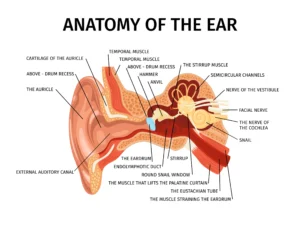 Ear wax, also known as cerumen, is a natural substance produced by the glands in the ear canal. It serves important functions such as protecting the ear canal from dust, debris, and microbial invaders. However excessive accumulation or impaction of ear wax can lead to discomfort, hearing loss, and even ear infections. As such, safe and effective ear wax removal methods are essential for maintaining ear health and preserving hearing function.
Ear wax, also known as cerumen, is a natural substance produced by the glands in the ear canal. It serves important functions such as protecting the ear canal from dust, debris, and microbial invaders. However excessive accumulation or impaction of ear wax can lead to discomfort, hearing loss, and even ear infections. As such, safe and effective ear wax removal methods are essential for maintaining ear health and preserving hearing function.
Today, we explore the various methods and techniques for removing ear wax safely at home. Also, highlight best practices and address common misconceptions.
Understanding Ear Wax
Ear wax is a mixture of secretions from the ceruminous and sebaceous glands in the ear canal, along with dead skin cells and other debris. It serves as a natural lubricant and protective barrier, helping to trap foreign particles and prevent them from entering the delicate structures of the inner ear.
However, factors such as genetics, age, and individual ear anatomy can influence the amount and consistency of ear wax produced.
Signs of Excessive Ear Wax
While a certain amount of ear wax is normal and beneficial, excessive buildup or impaction of ear wax can lead to symptoms such as:
- Earache or discomfort
- A feeling of fullness or blockage in the ear
- Decreased hearing or temporary hearing loss
- Tinnitus (ringing or buzzing in the ear)
- Itching or irritation in the ear canal
Safe Methods for Ear Wax Removal
There are several safe and effective methods for removing excess ear wax at home. These include:
- Softening Drops. Over-the-counter ear drops containing water, saline, hydrogen peroxide, or glycerin can help soften ear wax, making it easier to remove.
- Irrigation. Flushing the ear with warm water using a bulb syringe or special irrigation kit can help dislodge and flush out ear wax. It is important to use lukewarm water to avoid dizziness or discomfort.
- Manual Removal. In some cases, ear wax may need to be manually removed by a healthcare professional using specialized tools such as a curette or suction device. Attempting to remove ear wax manually at home using cotton swabs or other objects can push the wax deeper into the ear canal and potentially cause injury.
Avoiding Common Pitfalls
While it may be tempting to use cotton swabs or other makeshift tools to remove ear wax, these methods can do more harm than good. Cotton swabs can push ear wax deeper into the ear canal, leading to impaction or injury to the eardrum. Additionally, inserting objects into the ear canal increases the risk of infection or damage to the delicate structures of the ear.
Safe and effective ear wax removal is essential for maintaining ear health and preserving hearing function. By understanding the role of ear wax, recognizing the signs of excessive buildup, and utilizing safe removal methods, individuals can prevent discomfort, hearing loss, and complications associated with impacted ear wax.
When in doubt, it is always best to seek guidance from a healthcare professional who can safely assess and address ear wax concerns. With proper care and attention, individuals can enjoy clear, comfortable ears and optimal hearing health.
Picture Credit: Freepik
